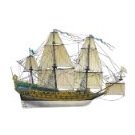
Bob Cleek
-
Posts
3,374 -
Joined
-
Last visited
Reputation Activity
-
 Bob Cleek reacted to Glen McGuire in Charles W Morgan by Glen McGuire - FINISHED - 1/400 – BOTTLE
Bob Cleek reacted to Glen McGuire in Charles W Morgan by Glen McGuire - FINISHED - 1/400 – BOTTLE
Based on the pictures I’ve seen of the Morgan, it looks like there is a little quarter deck on the bow. Not sure what it’s called but I added one.
-
 Bob Cleek got a reaction from mtaylor in Single layer planking
Bob Cleek got a reaction from mtaylor in Single layer planking
A single layer of planking requires careful layout and fitting, while double planking covers a multitude of sins. It's easier to bend two layers of thin plank than a thicker one, until you get the hang of it. Actually, single planking is easier in my opinion because it's easier to clamp to the frames. Kit manufacturers opt for the double planking because it offers the less-experienced builder an easier go of it and because they can get away with less expensive wood for the first layer. Today's top quality models seem all to be single layer planking, sometimes with the planks laser-cut to save the builder having to spile their own planks. I think many modelers find their first single planked model marks the end of their double planking days. Other's mileage may vary, of course.
-
 Bob Cleek got a reaction from wefalck in Single layer planking
Bob Cleek got a reaction from wefalck in Single layer planking
A single layer of planking requires careful layout and fitting, while double planking covers a multitude of sins. It's easier to bend two layers of thin plank than a thicker one, until you get the hang of it. Actually, single planking is easier in my opinion because it's easier to clamp to the frames. Kit manufacturers opt for the double planking because it offers the less-experienced builder an easier go of it and because they can get away with less expensive wood for the first layer. Today's top quality models seem all to be single layer planking, sometimes with the planks laser-cut to save the builder having to spile their own planks. I think many modelers find their first single planked model marks the end of their double planking days. Other's mileage may vary, of course.
-
 Bob Cleek reacted to Roger Pellett in Single layer planking
Bob Cleek reacted to Roger Pellett in Single layer planking
Back in the day, Ship model kits were centered on machine carved solid wooden hulls; a technology invented over 100 years earlier to mass produce wooden gun stocks. The model maker finish carved the hull, and added stempost, sternpost, keel, etc. In the hands of a skilled modelmaker excellent and accurate models could be produced from these kits.
In the 1970’s-1980’s these kits began to be displaced by European Plank on Bulkhead kits that claimed to allow models “to be built like the real ship,” even though with their widely spaced bulkheads they had more in common with model aircraft. Comparing the two types of kits, it’s easy to see why European kit manufacturers favored their system. It cost them much less to provide and ship strip and sheet stock than large blocks of quality wood. It is also possible that novice model makers found this form of construction less intimidating than finish carving a solid hull, until they began planking, but by that time they had already spent their money.
But now the kit manufacturers had another problem. Bending strips of wood around a few widely spaced bulkheads would not necessarily provide a fair (smooth) hull, let alone one that faithfully represented the actual ship. To overcome this problem, they adopted the Double Planking System. By using this system, the builder has an opportunity to fair his hull before adding the second planking layer. Just like the real thing? Hardly!
If for some reason I was to build one of these kits, I’d add solid blocks between the bulkheads and properly fair the hull. Then I’d plank the hull with a single layer of quality planking. But if I were going to go to this effort, I’d just rather build a model from scratch.
Roger
-
 Bob Cleek reacted to Jaager in Single layer planking
Bob Cleek reacted to Jaager in Single layer planking
It is my thought that double layer planking is used when the number of moulds is too few to allow a single layer of planking of any thickness to support a proper run without hollows.
-
 Bob Cleek got a reaction from druxey in Single layer planking
Bob Cleek got a reaction from druxey in Single layer planking
A single layer of planking requires careful layout and fitting, while double planking covers a multitude of sins. It's easier to bend two layers of thin plank than a thicker one, until you get the hang of it. Actually, single planking is easier in my opinion because it's easier to clamp to the frames. Kit manufacturers opt for the double planking because it offers the less-experienced builder an easier go of it and because they can get away with less expensive wood for the first layer. Today's top quality models seem all to be single layer planking, sometimes with the planks laser-cut to save the builder having to spile their own planks. I think many modelers find their first single planked model marks the end of their double planking days. Other's mileage may vary, of course.
-
 Bob Cleek got a reaction from Canute in Proxxon FET Inquiry
Bob Cleek got a reaction from Canute in Proxxon FET Inquiry
I hear you on that! It seems to be a problem just about everywhere outside the US, if comments on MSW are any indication. I see that Barrie, Ontario is only about 145 miles from Buffalo, New York. An affordable Jim Saw may be closer than you think.
If my memory of his prior posts serves, MSW forumite Kevin Kenny, who lives in Trinidad and Tobago, has found it impossible to obtain many modeling essentials in his homeland and solves that problem by stocking up on tools and supplies whenever he visits his daughter in New York. He may be able to share some pointers on how that works for him.
-
 Bob Cleek got a reaction from govtech in Missing parts
Bob Cleek got a reaction from govtech in Missing parts
Ah, yes. It happens. Go to a local craft or bead store and I'm sure you will easily find something that fits the scale of your model perfectly. They are just round beads. They come in a million colors and sizes. No problem.
-
 Bob Cleek got a reaction from DARIVS ARCHITECTVS in Missing parts
Bob Cleek got a reaction from DARIVS ARCHITECTVS in Missing parts
Ah, yes. It happens. Go to a local craft or bead store and I'm sure you will easily find something that fits the scale of your model perfectly. They are just round beads. They come in a million colors and sizes. No problem.
-
 Bob Cleek got a reaction from mtaylor in Missing parts
Bob Cleek got a reaction from mtaylor in Missing parts
Ah, yes. It happens. Go to a local craft or bead store and I'm sure you will easily find something that fits the scale of your model perfectly. They are just round beads. They come in a million colors and sizes. No problem.
-
 Bob Cleek got a reaction from Roger Pellett in Missing parts
Bob Cleek got a reaction from Roger Pellett in Missing parts
Ah, yes. It happens. Go to a local craft or bead store and I'm sure you will easily find something that fits the scale of your model perfectly. They are just round beads. They come in a million colors and sizes. No problem.
-
 Bob Cleek got a reaction from michael mott in Skipjack by michael mott - 1/8th scale - SMALL - 19 foot open launch
Bob Cleek got a reaction from michael mott in Skipjack by michael mott - 1/8th scale - SMALL - 19 foot open launch
Great news, Michael. I'm looking forward to watching you back at work soon!
-
 Bob Cleek got a reaction from Keith Black in Skipjack by michael mott - 1/8th scale - SMALL - 19 foot open launch
Bob Cleek got a reaction from Keith Black in Skipjack by michael mott - 1/8th scale - SMALL - 19 foot open launch
Great news, Michael. I'm looking forward to watching you back at work soon!
-
 Bob Cleek got a reaction from mtaylor in Skipjack by michael mott - 1/8th scale - SMALL - 19 foot open launch
Bob Cleek got a reaction from mtaylor in Skipjack by michael mott - 1/8th scale - SMALL - 19 foot open launch
Great news, Michael. I'm looking forward to watching you back at work soon!
-
 Bob Cleek reacted to Roger Pellett in A downsizing sale - ALL ITEMS SOLD
Bob Cleek reacted to Roger Pellett in A downsizing sale - ALL ITEMS SOLD
Glen,
I’d be interested in the Byrnes sander at $160 plus shipping. I don’t have a Paypal account or any thing like that. I propose to send you a check and you send me the sander when you cash it.
Send me a PM with details.
BTW, I believe that one of the miter gages goes with the sander.
Roger
-
 Bob Cleek got a reaction from Landlubber Mike in Priming Below the Waterline
Bob Cleek got a reaction from Landlubber Mike in Priming Below the Waterline
The distinction between primer and sanding undercoat is often overlooked. Primer is thin and soaks into the bare wood surface. It can be thinned paint or shellac. I prefer shellac as it is thinned with alcohol and dries quickly to a hard coating that sands easily while penetrating the wood well. For those using water-based acrylics, you should not use a water-based primer on bare wood because the water will raise the grain on the bare wood surface. For this reason, among others, my standard primer is shellac. (Which is also cheap and readily available!)
Applying repeated coats of thin primer will take much longer to fill grain and other imperfections, as will applying repeated costs of finish paint. Sanding undercoat is a huge time-saver. Also note that filling imperfections with sanding undercoat has its limitations. It isn't intended for filling a 1/32" gap in planking. For that use surfacing putty (sometimes called "fairing putty",) which is a peanut-butter consistency acetone-thinned material similar to sanding undercoat that is used for filling larger imperfections. Surfacing putty should be covered with primer or sanding undercoat after sanding fair and before applying any finish paint because it may absorb some of the later-applied coating and create a visible difference in the later coat, often a "flat finish" that sticks out like a sore thumb on a gloss finish coat.
Once primed, a sanding undercoat is used to fill the small imperfections and grain. This undercoat paint is relatively thick and contains a fair portion of talc (chalk) which is what thickens it so it will fill the low spots and makes it very easy to sand. The undercoat, when fully dried, is sanded smooth. If some imperfections remain, another coat is applied and sanded again, and so on until the surface is perfect. Close examination under good light is preferred, and for final examination running the fingertips lightly over the surface is recommended because your fingertips are more sensitive for judging smoothness than your eyes. Only after the surface is prepared in this fashion, should one apply the finish coats thinly until the desired finish is achieved.
Oil-based sanding undercoat can be covered by water-based finishes because it is sufficiently flat to provide a mechanical bond, although if one is using a water-based finish coat, it's safer to use water-based sanding undercoat. Oil-based paint and varnish are preferred for fine finishes due to their more durable harder surfaces which are easier to sand and polish. However, many prefer acrylics for their faster drying time and other more user-friendly qualities.
'
And the one rule that must often be followed and is rarely mentioned is to always, always, always, test every paint or varnish you are going to use on a scrap of the same material you are going to finish before you start applying it to the finished workpiece! This may be difficult for the impatient, but the additional time taken will ensure you avoid tremendous grief. Finishing is sometimes a mysterious process. Sometimes the smallest differences in the mixing of materials, their age, or the ambient environment can result in a failure, usually in adhesion or drying. It's often difficult to know why and frequently unpredictable. It's far better to know that before you've an applied incompatible or defective coating to an entire hull or to small, detailed parts that are nearly impossible to strip and start over on.
-
 Bob Cleek got a reaction from EricWilliamMarshall in Clayton Feldman's "Compleat (almost) Two Foot Library"
Bob Cleek got a reaction from EricWilliamMarshall in Clayton Feldman's "Compleat (almost) Two Foot Library"
You must be a ruthless culler!
-
 Bob Cleek got a reaction from BobG in Proxxon FET Inquiry
Bob Cleek got a reaction from BobG in Proxxon FET Inquiry
I hear you on that! It seems to be a problem just about everywhere outside the US, if comments on MSW are any indication. I see that Barrie, Ontario is only about 145 miles from Buffalo, New York. An affordable Jim Saw may be closer than you think.
If my memory of his prior posts serves, MSW forumite Kevin Kenny, who lives in Trinidad and Tobago, has found it impossible to obtain many modeling essentials in his homeland and solves that problem by stocking up on tools and supplies whenever he visits his daughter in New York. He may be able to share some pointers on how that works for him.
-
 Bob Cleek got a reaction from Gregory in Proxxon FET Inquiry
Bob Cleek got a reaction from Gregory in Proxxon FET Inquiry
I hear you on that! It seems to be a problem just about everywhere outside the US, if comments on MSW are any indication. I see that Barrie, Ontario is only about 145 miles from Buffalo, New York. An affordable Jim Saw may be closer than you think.
If my memory of his prior posts serves, MSW forumite Kevin Kenny, who lives in Trinidad and Tobago, has found it impossible to obtain many modeling essentials in his homeland and solves that problem by stocking up on tools and supplies whenever he visits his daughter in New York. He may be able to share some pointers on how that works for him.
-
 Bob Cleek got a reaction from mtaylor in Proxxon FET Inquiry
Bob Cleek got a reaction from mtaylor in Proxxon FET Inquiry
I hear you on that! It seems to be a problem just about everywhere outside the US, if comments on MSW are any indication. I see that Barrie, Ontario is only about 145 miles from Buffalo, New York. An affordable Jim Saw may be closer than you think.
If my memory of his prior posts serves, MSW forumite Kevin Kenny, who lives in Trinidad and Tobago, has found it impossible to obtain many modeling essentials in his homeland and solves that problem by stocking up on tools and supplies whenever he visits his daughter in New York. He may be able to share some pointers on how that works for him.
-
 Bob Cleek got a reaction from Canute in I need my tubes cut
Bob Cleek got a reaction from Canute in I need my tubes cut
This thread shouldn't be eliminated. It should be preserved for posterity. It proves that determination and thought will provide the solution of most any daunting modeling challenge. As they say, "It shows you're thinking!" All to often, someone posts a question, gets the answer, and then argues about why it can't be done that way.
-
 Bob Cleek got a reaction from Canute in Clayton Feldman's "Compleat (almost) Two Foot Library"
Bob Cleek got a reaction from Canute in Clayton Feldman's "Compleat (almost) Two Foot Library"
You must be a ruthless culler!
-
 Bob Cleek got a reaction from Canute in Clayton Feldman's "Compleat (almost) Two Foot Library"
Bob Cleek got a reaction from Canute in Clayton Feldman's "Compleat (almost) Two Foot Library"
It might have been a good start twenty years ago, but nothing more. Continually acquiring related research materials as one goes along is an essential part of this hobby. The technology of modeling has increased and complexified tremendously in the twenty years since that was written. I would say that any of the then-contemporary "how-to-do-it" books are fairly obsolete by now, save for the very few "classics." Avoid anything with the words "How to" in the title. For example, you will hear about frequently-recommended books on how to build kits, but they will have been written in the days of double "plank on bulkhead" construction long before laser-cut parts and photo-etched fittings became commonplace and they really fall short of addressing what a quality kit can produce today. They are generally a waste of money. There will always be yet another "must-have" volume to acquire. If someone starting out asked me, I'd advise them to first acquire the "classics" that have stood the test of time, such as the books by Davis, Underhill, Longridge, and The Ship Modeler's Shopnotes I and II on modeling technique and Chapelle on American period vessels, if that's your focus of interest. Wrap your head around that information, then take it from there. Also, don't limit your selections to specifically ship modeling books, either. Any good book on any of the related crafts will contribute to making you a better modeler. You will, eventually, want to know about various wood species and their qualities, how to cut, turn, and carve wood, how to finish wood, how to fabricate metal parts and join them together, how to sew, how to make your own scale cordage, how to read "lines drawings" and do drafting, both manual and CAD, if that's your cup of tea, and on and on. This is what makes this hobby one that can stay with you for a lifetime.
-
 Bob Cleek got a reaction from Scottish Guy in For Beginners -- A Cautionary Tale
Bob Cleek got a reaction from Scottish Guy in For Beginners -- A Cautionary Tale
I agree! You just assemble a plastic kit. "Glue part number 5A into hole number 5B" and so on. There's no need to understand what the part is called or what its function might be. To a greater extent, particularly with earlier wooden models, be they ship or otherwise, at least before laser cutting, is was just assumed by the manufacturers that their customers has some basic understanding of what they were building and adequate woodworking skills to cut and fit the parts together. Unfortunately, many of recent generations are often clueless when it comes to the manual arts and the high schools by and large abandoning their shop classes hasn't helped any, either. Anybody starting in out in sailing ship modeling would do well to start by reading Chapelle's Boatbuilding and learning how a wooden boat is built from the lines up. That will make their modeling tasks much more understandable. Of course, such advice would be sure to fall on deaf ears in this age of instant gratification. How many kids today know "righty-tighty, lefty-loosey?"
-
 Bob Cleek got a reaction from Rik Thistle in For Beginners -- A Cautionary Tale
Bob Cleek got a reaction from Rik Thistle in For Beginners -- A Cautionary Tale
I agree! You just assemble a plastic kit. "Glue part number 5A into hole number 5B" and so on. There's no need to understand what the part is called or what its function might be. To a greater extent, particularly with earlier wooden models, be they ship or otherwise, at least before laser cutting, is was just assumed by the manufacturers that their customers has some basic understanding of what they were building and adequate woodworking skills to cut and fit the parts together. Unfortunately, many of recent generations are often clueless when it comes to the manual arts and the high schools by and large abandoning their shop classes hasn't helped any, either. Anybody starting in out in sailing ship modeling would do well to start by reading Chapelle's Boatbuilding and learning how a wooden boat is built from the lines up. That will make their modeling tasks much more understandable. Of course, such advice would be sure to fall on deaf ears in this age of instant gratification. How many kids today know "righty-tighty, lefty-loosey?"









.thumb.jpeg.fc5d633a7b34428fcf19419a73d56d55.jpeg)
